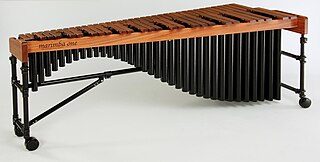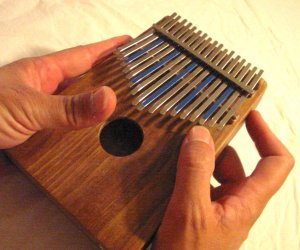
A percussion instrument is a musical instrument that is sounded by being struck or scraped by a beater including attached or enclosed beaters or rattles struck, scraped or rubbed by hand or struck against another similar instrument. Excluding zoomusicological instruments and the human voice, the percussion family is believed to include the oldest musical instruments. In spite of being a very common term to designate instruments, and to relate them to their players, the percussionists, percussion is not a systematic classificatory category of instruments, as described by the scientific field of organology. It is shown below that percussion instruments may belong to the organological classes of idiophone, membranophone, aerophone and chordophone.

The washtub bass, or gutbucket, is a stringed instrument used in American folk music that uses a metal washtub as a resonator. Although it is possible for a washtub bass to have four or more strings and tuning pegs, traditional washtub basses have a single string whose pitch is adjusted by pushing or pulling on a staff or stick to change the tension.

The xylophone is a musical instrument in the percussion family that consists of wooden bars struck by mallets. Like the glockenspiel, the xylophone essentially consists of a set of tuned wooden keys arranged in the fashion of the keyboard of a piano. Each bar is an idiophone tuned to a pitch of a musical scale, whether pentatonic or heptatonic in the case of many African and Asian instruments, diatonic in many western children's instruments, or chromatic for orchestral use.

The marimba is a musical instrument in the percussion family that consists of wooden bars that are struck by mallets. Below each bar is a resonator pipe that amplifies particular harmonics of its sound. Compared to the xylophone, the marimba has a lower range. Typically, the bars of a marimba are arranged chromatically, like the keys of a piano. The marimba is a type of idiophone.

The vibraphone is a percussion instrument in the metallophone family. It consists of tuned metal bars and is typically played by using mallets to strike the bars. A person who plays the vibraphone is called a vibraphonist,vibraharpist, or vibist.

The celesta or celeste, also called a bell-piano, is a struck idiophone operated by a keyboard. It looks similar to an upright piano, albeit with smaller keys and a much smaller cabinet, or a large wooden music box (three-octave). The keys connect to hammers that strike a graduated set of metal plates or bars suspended over wooden resonators. Four- or five-octave models usually have a damper pedal that sustains or damps the sound. The three-octave instruments do not have a pedal because of their small "table-top" design. One of the best-known works that uses the celesta is Pyotr Ilyich Tchaikovsky's "Dance of the Sugar Plum Fairy" from The Nutcracker.
Hornbostel–Sachs or Sachs–Hornbostel is a system of musical instrument classification devised by Erich Moritz von Hornbostel and Curt Sachs, and first published in the Zeitschrift für Ethnologie in 1914. An English translation was published in the Galpin Society Journal in 1961. It is the most widely used system for classifying musical instruments by ethnomusicologists and organologists. The system was updated in 2011 as part of the work of the Musical Instrument Museums Online (MIMO) Project.

A metallophone is any musical instrument in which the sound-producing body is a piece of metal, such as tuned metal bars, tubes, rods, bowls, or plates. Most frequently the metal body is struck to produce sound, usually with a mallet, but may also be activated by friction, keyboard action, or other means.

The tanpura is a long-necked, plucked, four-stringed instrument originating in India, found in various forms in Indian music. Visually, the tanpura resembles a simplified sitar or similar lute-like instrument, and is likewise crafted out of a gourd or pumpkin.

A lamellophone is a member of the family of musical instruments that makes its sound by a thin vibrating plate called a lamella or tongue, which is fixed at one end and has the other end free. When the musician depresses the free end of a plate with a finger or fingernail, and then allows the finger to slip off, the released plate vibrates. An instrument may have a single tongue or a series of multiple tongues.

The Stroh violin or Stroviol is a type of stringed musical instrument that is mechanically amplified by a metal resonator and horn attached to its body. The name Stroviol refers to a violin, but other instruments have been modified with the amplification device, including the viola, cello, double bass, ukulele, mandolin, and guitar. Johannes Matthias Augustus Stroh, an electrical engineer from Frankfurt, invented the instrument in London in 1899.

A gangsa is a type of metallophone which is used mainly in Balinese and Javanese Gamelan music in Indonesia. In Balinese gong kebyar styles, there are two types of gangsa typically used: the smaller, higher pitched kantilan and the larger pemade. Each instrument consists of several tuned metal bars each placed over an individual resonator. The bars are hit with a wooden panggul, each producing a different pitch. Duration of sound intensity and sound quality factors are generally accomplished by damping the vibration of the bar with the fingers of the free hand. Balinese gong kebyar gangsas, as with other metallophones in gong kebyar ensembles, are played in neighboring pairs with interlocking, rapid-tempo parts that elaborate on the melody of a piece of music ; these pairs are tuned to be dissonant and create certain wavelengths of sympathetic vibrations to create a shimmering tone that travels long distances. The gangsa is very similar to the old gendér and the saron.
The long-string instrument is a musical instrument in which the string is of such a length that the fundamental transverse wave is below what a person can hear as a tone (±20 Hz). If the tension and the length result in sounds with such a frequency, the tone becomes a beating frequency that ranges from a short reverb to longer echo sounds. Besides the beating frequency, the string also gives higher pitched natural overtones. Since the length is that long, this has an effect on the attack tone. The attack tone shoots through the string in a longitudinal wave and generates the typical science-fiction laser-gun sound as heard in Star Wars. The sound is also similar to that occurring in upper electricity cables for trains.

The nail violin is a musical instrument which was invented by German violinist Johann Wilde in 1740. The instrument consists of a semicircular wooden soundboard, approximately 1.5 feet (46 cm) by 1 foot (30 cm) in size, with iron or brass nails of different lengths arranged to produce a chromatic scale when bowed.

The slenthem is an Indonesian metallophone which makes up part of a Javanese gamelan orchestra. The slenthem is part of the gendér family. It consists of a set of bronze keys comprising a single octave: there are six keys when playing the slendro scale and seven when playing the pelog. These keys are suspended by leather cords over individual bamboo tube resonators in a wooden frame, which are cut so that the placement of the bamboo's node causes the functional length of the resonator to be shorter for higher notes. The instrument is played by striking the keys with a mallet, called a tabuh, which has a short handle and a thin wooden disk edged in cloth or rubber. One hand is left free to dampen notes. It is a low-pitched instrument with a softer sound than the saron demung.
The Triolin is an acoustic bowed metal instrument designed and built by Hal Rammel in 1991. He has described it as a nail violin gone awry. Thin metal rods sit perpendicular in a circular arrangement on the top surface of a triangular wooden resonator and the instrument is held in the other hand by an ornately carved chair leg attached to the bottom of the resonator. Thus, the rods can be bowed as the entire instrument twists and spins underneath. Several years later, when he began to experiment with amplification inspired by the live electronics of cellist Russell Thorne and the amplified table top arrays of Hugh Davies, he attached wooden rods to a flat wooden artist's palette. His amplified palette can be heard on the 1994 CD Elsewheres and, more recently, on "Like Water, Tightly Wound". In 2013 the triolin and four amplified palettes by Hal Rammel were added to the permanent collection of the National Music Museum in Vermillion, South Dakota along with many other acoustic instruments he performed with in the 1990s in Chicago.

A vessel flute is a type of flute with a body which acts as a Helmholtz resonator. The body is a vessel-shaped, not a tube- or cone-shaped; that is, the far end is closed.
Robert Rutman was a German visual artist, musician, composer, and instrument builder. Best known for his work with homemade idiophones in his Steel Cello Ensemble, Rutman is regarded as a pioneer of multimedia performance in his mixing of music, sculpture, film, and visual art.















